HDLBits——Latches and Flip-Flops
Posted Mount256
tags:
篇首语:本文由小常识网(cha138.com)小编为大家整理,主要介绍了HDLBits——Latches and Flip-Flops相关的知识,希望对你有一定的参考价值。
HDLBits(9)——Latches and Flip-Flops
- ----- 81. D flip-flop -----
- ----- 82. D flip-flops -----
- ----- 83. DFF with reset -----
- ----- 84. DFF with reset value -----
- ----- 85. DFF with asynchronous reset -----
- ----- 86. DFF with byte enable -----
- ----- 87. D Latch -----
- ----- 88. DFF (asynchronous reset) -----
- ----- 89. DFF (synchronous reset) -----
- ----- 90. DFF+gate -----
- ----- 91. Mux and DFF (a) -----
- ----- 92. Mux and DFF (b) -----
- ----- 93. DFFs and gates -----
- ----- 94. Create circuits from truth table -----
- ----- 95. Detect an edge -----
- ----- 96. Detect both edges -----
- ----- 97. Edge capture register -----
- ----- 98. Dual-edge triggered flip-flop -----
----- 81. D flip-flop -----
Problem Statement
A D flip-flop is a circuit that stores a bit and is updated periodically, at the (usually) positive edge of a clock signal.

D flip-flops are created by the logic synthesizer when a clocked always block is used. A D flip-flop is the simplest form of “blob of combinational logic followed by a flip-flop” where the combinational logic portion is just a wire.
Create a single D flip-flop.
Answer
module top_module (
input clk, // Clocks are used in sequential circuits
input d,
output reg q );//
// Use a clocked always block
// copy d to q at every positive edge of clk
// Clocked always blocks should use non-blocking assignments
always @(posedge clk)
q <= d;
endmodule
----- 82. D flip-flops -----
Problem Statement
Create 8 D flip-flops. All DFFs should be triggered by the positive edge of clk.
Answer1
module top_module (
input clk,
input [7:0] d,
output [7:0] q
);
integer i;
always @(posedge clk) begin
for (i = 7; i >= 0; i = i - 1) begin
q[i] <= d[i];
end
end
endmodule
Answer2
module top_module(
input clk,
input [7:0] d,
output reg [7:0] q);
always @(posedge clk)
q <= d;
endmodule
----- 83. DFF with reset -----
Problem Statement
Create 8 D flip-flops with active high synchronous reset(同步复位,高电平有效). All DFFs should be triggered by the positive edge of clk.
Answer
module top_module (
input clk,
input reset, // Synchronous reset
input [7:0] d,
output [7:0] q
);
always @(posedge clk) begin
if(reset == 1'b1)
q <= 0;
else
q <= d;
end
endmodule
----- 84. DFF with reset value -----
Problem Statement
Create 8 D flip-flops with active high synchronous reset. The flip-flops must be reset to 0x34 rather than zero. All DFFs should be triggered by the negative edge of clk.
Answer
module top_module (
input clk,
input reset,
input [7:0] d,
output [7:0] q
);
always @(negedge clk) begin
if(reset == 1'b1)
q <= 8'h34;
else
q <= d;
end
endmodule
----- 85. DFF with asynchronous reset -----
Problem Statement
Create 8 D flip-flops with active high asynchronous reset(异步复位,高电平有效). All DFFs should be triggered by the positive edge of clk.
Answer
module top_module (
input clk,
input areset, // active high asynchronous reset
input [7:0] d,
output [7:0] q
);
always @(posedge clk or posedge areset) begin
if(areset == 1'b1)
q <= 0;
else
q <= d;
end
endmodule
(批注:异步复位需要将复位信号写入敏感列表中,并且注明是上升沿(高电平)有效还是下降沿(低电平)有效;同步复位不用写入列表中)
----- 86. DFF with byte enable -----
Problem Statement
Create 16 D flip-flops. It’s sometimes useful to only modify parts of a group of flip-flops. The byte-enable inputs control whether each byte of the 16 registers should be written to on that cycle. byteena[1] controls the upper byte d[15:8], while byteena[0] controls the lower byte d[7:0].
resetn is a synchronous, active-low reset(同步复位,低电平有效).
All DFFs should be triggered by the positive edge of clk.
Answer
module top_module (
input clk,
input resetn,
input [1:0] byteena,
input [15:0] d,
output [15:0] q
);
always @(posedge clk) begin
if (resetn == 1'b0)
q <= 0;
else
case(byteena)
2'b00: q <= q;
2'b01: q[7:0] <= d[7:0];
2'b10: q[15:8] <= d[15:8];
2'b11: q <= d;
endcase
end
endmodule
----- 87. D Latch -----
Problem Statement
Implement the following circuit:

Note that this is a latch(锁存器), so a Quartus warning about having inferred a latch is expected.
Answer
module top_module (
input d,
input ena,
output q);
always @(ena) begin
if(ena == 1'b1)
q <= d;
else
q <= q;
end
endmodule
(批注:若在always列表改成posedge ena,会综合出触发器(flip-flops))
(锁存器和触发器的区别是:锁存器对输入电平(使能信号)敏感,触发器对时钟信号敏感)
----- 88. DFF (asynchronous reset) -----
Problem Statement
Implement the following circuit:
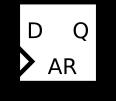
Answer
module top_module (
input clk,
input d,
input ar, // asynchronous reset
output q);
always @(posedge clk or posedge ar) begin
if (ar == 1'b1)
q <= 0;
else
q <= d;
end
endmodule
----- 89. DFF (synchronous reset) -----
Problem Statement
Implement the following circuit:
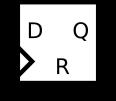
Answer
module top_module (
input clk,
input d,
input r, // synchronous reset
output q);
always @(posedge clk) begin
if (r == 1'b1)
q <= 0;
else
q <= d;
end
endmodule
----- 90. DFF+gate -----
Problem Statement
Implement the following circuit:

Answer
module top_module (
input clk,
input in,
output out);
wire io;
assign io = in ^ out;
my_dff my_dff1(.clk(clk), .d(io), .q(out));
endmodule
module my_dff(
input clk,
input d,
output reg q );
always @(posedge clk)
q <= d;
endmodule
----- 91. Mux and DFF (a) -----
Problem Statement
Consider the sequential circuit below:
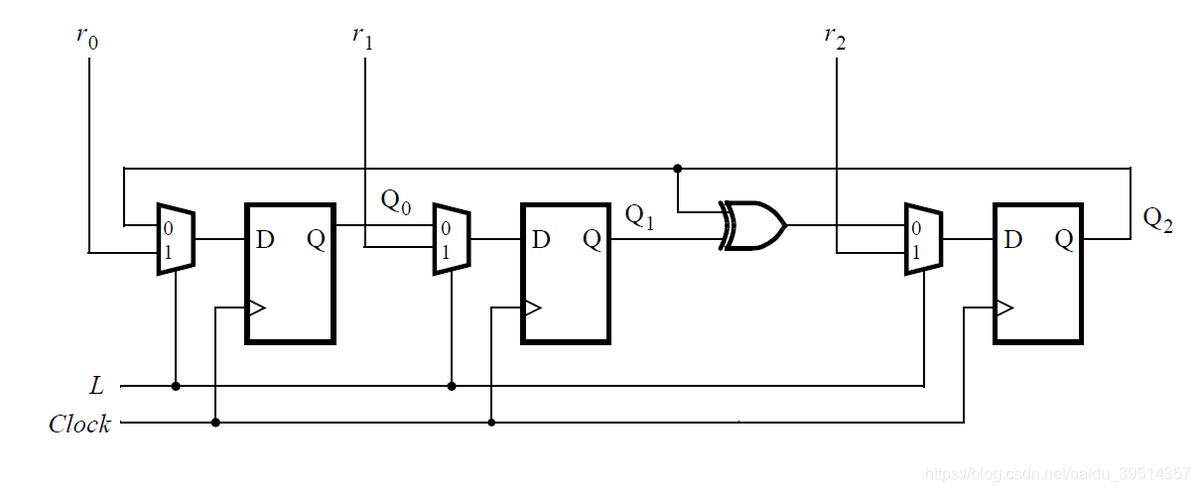
Assume that you want to implement hierarchical Verilog code for this circuit, using three instantiations of a submodule that has a flip-flop and multiplexer in it. Write a Verilog module (containing one flip-flop and multiplexer) named top_module for this submodule. (批注:写出子模块即可!!!)
Answer
module top_module (
input clk,
input L,
input r_in,
input q_in,
output reg Q);
wire out;
assign out = L ? r_in : q_in;
always @(posedge clk)
Q <= out;
endmodule
----- 92. Mux and DFF (b) -----
Problem Statement
Consider the n-bit shift register circuit shown below:

Write a Verilog module named top_module for one stage of this circuit, including both the flip-flop and multiplexers. (批注:与上题一样,写出子模块即可!!!)
Answer
module top_module (
input clk,
input w, R, E, L,
output Q
);
wire io1, io2;
assign io1 = E ? w : Q;
assign io2 = L ? R : io1;
always @(posedge clk) begin
Q <= io2;
end
endmodule
----- 93. DFFs and gates -----
Problem Statement
Given the finite state machine circuit as shown, assume that the D flip-flops are initially reset to zero before the machine begins.
Build this circuit.
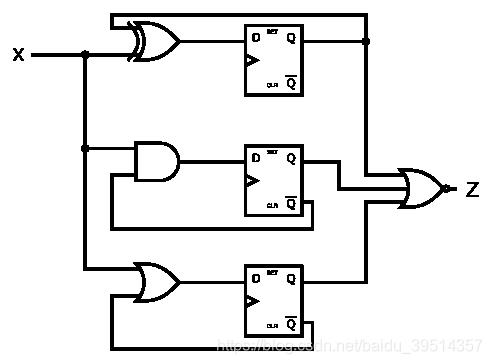
Answer
module top_module (
input clk,
input x,
output z
);
wire xor_l, and_l, or_l;
wire Q1, Q2, Q3;
wire Qn1, Qn2, Qn3;
assign xor_l = x ^ Q1;
assign and_l = x & Qn2;
assign or_l = x | Qn3;
my_dff my_dff1 (.clk(clk), .d(xor_l), .q(Q1), .qn(Qn1));
my_dff my_dff2 (.clk(clk), .d(and_l), .q(Q2), .qn(Qn2));
my_dff my_dff3 (.clk(clk), .d(or_l), .q(Q3), .qn(Qn3));
assign z = ~(Q1 | Q2 | Q3);
endmodule
module my_dff(
input clk,
input d,
output reg q,
output qn
);
always @(posedge clk) begin
q <= d;
end
assign qn = ~q;
endmodule
(批注:若将qn = ~q写入always块中,将综合出两个D触发器,与题目要求不符)
----- 94. Create circuits from truth table -----
Problem Statement
A JK flip-flop(JK触发器) has the below truth table. Implement a JK flip-flop with only a D-type flip-flop and gates. Note: Qold is the output of the D flip-flop before the positive clock edge.
| J | K | Q |
|---|---|---|
| 0 | 0 | Qold |
| 0 | 1 | 0 |
| 1 | 0 | 1 |
| 1 | 1 | ~Qold |
Answer
module top_module (
input clk,
input j,
input k,
output Q);
wire [1:0] jk;
assign jk = {j, k};
always @(posedge clk) begin
case(jk)
2'b00: Q <= Q;
2'b01: Q <= 0;
2'b10: Q <= 1;
2'b11: Q <= ~Q;
endcase
end
endmodule
----- 95. Detect an edge -----
Problem Statement
(检测上升沿)
For each bit in an 8-bit vector, detect when the input signal changes from 0 in one clock cycle to 1 the next (similar to positive edge detection). The output bit should be set the cycle after a 0 to 1 transition occurs.
Here are some examples. For clarity, in[1] and pedge[1] are shown separately.

Answer
实现原理如下:

module top_module (
input clk,
input [7:0] in,
output [7:0] pedge
);
reg [7:0] temp1, temp2;
always @(posedge clk) begin
temp1 <= in;
temp2 <= temp1;
end
assign pedge = ~temp2 & temp1;
endmodule
----- 96. Detect both edges -----
Problem Statement
(检测上升沿和下降沿)
For each bit in an 8-bit vector, detect when the input signal changes from one clock cycle to the next (detect any edge). The output bit should be set the cycle after a 0 to 1 transition occurs.
Here are some examples. For clarity, in[1] and anyedge[1] are shown separately.

Answer
实现原理如下:

module top_module (
input clk,
input [7:0] in,
output [7:0] anyedge
);
reg [7:0] temp1, temp2;
always @(posedge clk) begin
temp1 <= in;
temp2 <= temp1;
end
assign anyedge = (~temp2 & temp1) | (temp2 & ~temp1);
endmodule
----- 97. Edge capture register -----
Problem Statement
(捕获输入信号的下降沿,捕获后维持高电平,复位后变为低电平,即为捕获寄存器)
For each bit in a 32-bit vector, capture when the input signal changes from 1 in one clock cycle to 0 the next. “Capture” means that the output will remain 1 until the register is reset (synchronous reset)(同步复位).
Each output bit behaves like a SR flip-flop(RS触发器): The output bit should be set (to 1) the cycle after a 1 to 0 transition occurs. The output bit should be reset (to 0) at the positive clock edge when reset is high. If both of the above events occur at the same time, reset has precedence(优先权). In the last 4 cycles of the example waveform below, the ‘reset’ event occurs one cycle earlier than the ‘set’ event, so there is no conflict here.
In the example waveform below, reset, in[1] and out[1] are shown again separately for clarity.
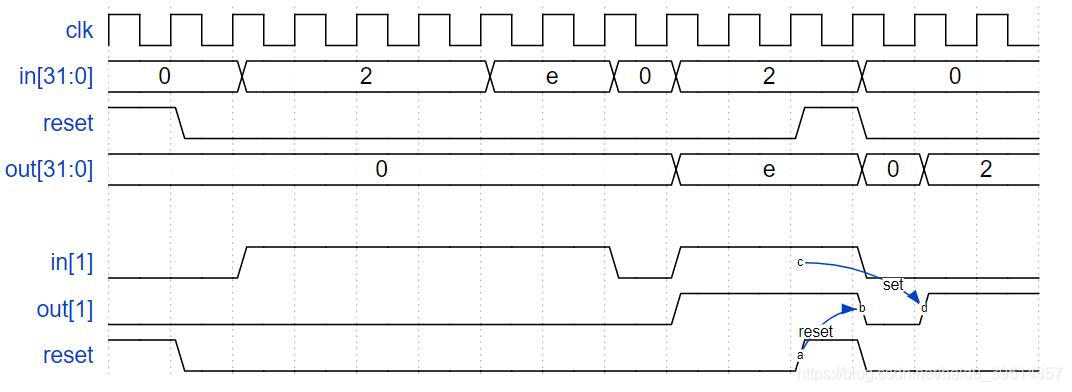
Answer
实现原理如下:

module top_module (
input clk,
input reset,
input [31:0] in,
output [31:0] out
);
reg [31:0] temp;
always @(posedge clk) begin
temp <= in;
if(reset)
out <= 32'b0;
else
out <= (temp & ~in) | out;
end
endmodule
----- 98. Dual-edge triggered flip-flop -----
Problem Statement
(双边沿D触发器)
You’re familiar with flip-flops that are triggered on the positive edge of the clock, or negative edge of the clock. A dual-edge triggered flip-flop is triggered on both edges of the clock. However, FPGAs don’t have dual-edge triggered flip-flops, and always @(posedge clk or negedge clk) is not accepted as a legal sensitivity list(敏感列表).
Build a circuit that functionally behaves like a dual-edge triggered flip-flop:

(Note: It’s not necessarily perfectly equivalent: The output of flip-flops have no glitches(脉冲,毛刺), but a larger combinational circuit that emulates this behaviour might. But we’ll ignore this detail here.)
Answer1
(上升沿和下降沿触发要分开写)
实现原理如下:

module top_module (
input clk,
input d,
output q
);
reg temp1, temp2;
always @(posedge clk)
temp1 <= d;
always @(negedge clk)
temp2 <= d;
always @(clk) begin
if(clk)
q = temp1;
else
q = temp2;
end
endmodule
Answer2
(网站给出的解法比较巧妙,利用了异或运算的可交换性)
module top_module(
input clk,
input d,
output q);
reg p, n;
// A positive-edge triggered flip-flop
always @(posedge clk)
p <= d ^ n;
// A negative-edge triggered flip-flop
always @(negedge clk)
n <= d ^ p;
// Why does this work?
// After posedge clk, p changes to d^n. Thus q = (p^n) = (d^n^n) = d.
// After negedge clk, n changes to p^n. Thus q = (p^n) = (p^p^n) = d.
// At each (positive or negative) clock edge, p and n FFs alternately
// load a value that will cancel out the other and cause the new value of d to remain.
assign q = p ^ n;
// Can't synthesize this.
/*always @(posedge clk, negedge clk) begin
q <= d;
end*/
endmodule
以上是关于HDLBits——Latches and Flip-Flops的主要内容,如果未能解决你的问题,请参考以下文章